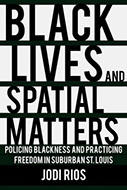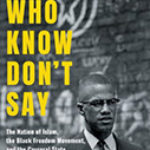Black Lives And Spatial Matters: Policing Blackness And Practicing Freedom In Suburban St. Louis

Author: Jodi Rios
Publisher: Ithaca, NY: Cornell University Press 2020. 294p.
Reviewer: R. Andra Greer | May 2021
In Black Lives and Spatial Matters, Jodi Rios provides an in-depth look into the practices of predatory policing, blackness as risk, and blackness as freedom within North St. Louis County. This book, while published after Ferguson, is not a direct result of the unrest there. Rather, Rios provides an analysis and articulation of the history of North St. Louis County that preceded the killing of Michael Brown in Ferguson, and a discussion of the mobilization and embodiment of freedom that followed.
The styles differ dramatically between the two parts, with Part I providing an in-depth historical and intellectual background while focusing on blackness as risk, and Part II engaging in blackness as freedom and the use of the body and space for the mobilization of resistance. A stylistic aspect that can be seen throughout, though featured a bit more in Part II, is that of direct quotes from interviewees. These often appear as strings of one quote after another, with little analysis or interpretation by Rios afterward. She acknowledged that this would be the case in her notes on method in the introduction, explaining that special attention should be given to the quotes, as they state experiences and points that she could not, and would not try to, explain any further herself. I found myself appreciating Rios’ reasoning for leaving the quotes as is, as I was thus allowed the opportunity to consider the content of the quotes as they were presented to me, and within the context of Rios’ larger historical and analytical discussion.
Methodologically, Rios brings an interdisciplinary approach to the work behind this book — which should be inviting to readers of all intellectual and scholarly backgrounds. Beginning this work as a faculty member of architecture and urban planning and design, Rios went through a process of undisciplining, in order to ground her work from a number of perspectives, including law, sociology, ethnic studies, and many others. Her use of multiple backgrounds does not make the book any more difficult to read because of the clarity and depth with which she develops and connects a breadth of scholarly perspectives. The interdisciplinary background contributed mightily to the completeness of her historical and analytical account of North St. Louis County, and helped untangle the relationships that make clear the conditions that led to the unrest there. Each perspective contributes something unique and meaningful to the understanding of how blackness as risk and space related to the experiences of many within suburban St. Louis, as well as how blackness as freedom is a distinct practice of imagining what could be – something Rios refers to as transforming from the power over life to the power of life – and is continuously led in particular by those who identify as black women and queer people of color. Her inclusion of diverse people, perspectives, disciplines, and methods is an amazing feature of this book, and invites those from all backgrounds to engage in a socially relevant and focused read.
Andra Greer, M.A., Kansas State University


